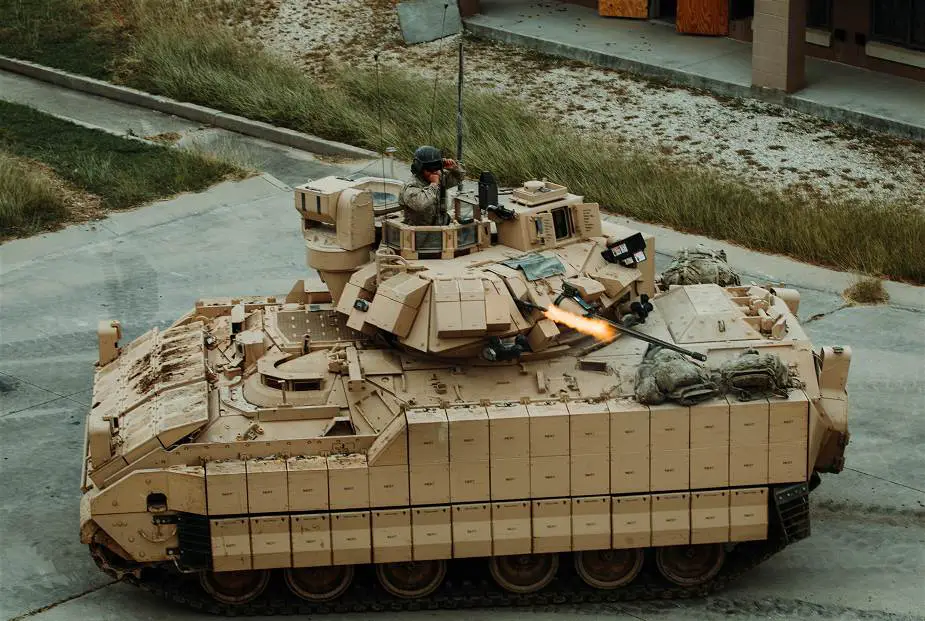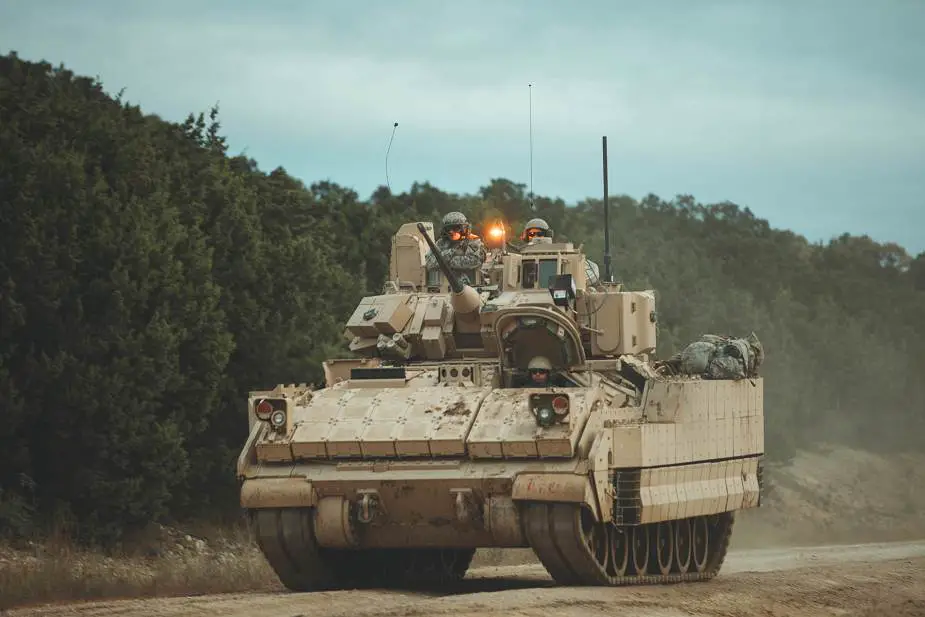Breaking news
US Army conducts field tests with new Bradley M2A4 tracked armored IFV.
According to pictures released by the U.S. Department of Defense (DoD) on October 24, 2020, the U.S. Army has tested the new version of the Bradley tracked armored IFV (Infantry Fighting Vehicle) named M2A4.
Follow Army Recognition on Google News at this link

U.S. soldiers assigned to 1st Battalion, 12th Cavalry Regiment, 3rd Armored Brigade Combat Team, 1st Cavalry Division, engage an opposing force during the testing of the newest version of the Bradley Fighting Vehicle, Fort Hood, Texas, Oct. 24, 2020. (Picture source U.S. Army)
U.S. soldiers of 1st Battalion, 12th Cavalry Regiment (1-12 CAV), 3rd Armored Brigade Combat Team (3ABCT), 1st Cavalry Division, spent several nights in the field getting to know the new the M2A4 and M7A4 Bradley versions. Linking up with test officers of the U.S. Army Operational Test Command (OTC) during a series of maneuvers and simulated force-on-force engagements, few Soldiers have had the chance to see the new machines in person, let alone get behind the wheel and test them.
During the testing, OTC (Operational Test Command) data collectors were on the ground with the Soldiers every step of the way gathering information that will later be used to analyze the overall capabilities of the vehicle in a report to senior Army leaders.
The new Bradley IFV variants offer a number of upgrades and overhauls. The idea behind the vehicle is to provide a faster, more durable, and survivable platform with increased oversight; according to Kummer, giving more power to the Troopers at the platoon and squad level to ensure success during large-scale ground combat operations.
In June 2018, BAE Systems had announced the rebuild and upgrade of 164 U.S. Army Bradley IFVs to the standard M2A4 and M7A4 configurations.
In October 2019, U.S. Army has awarded BAE Systems a contract for an additional 168 upgraded Bradley A4 Infantry Fighting Vehicles in the framework of U.S. Army’s combat vehicle modernization strategy and helps ensure force readiness of the Armored Brigade Combat Teams (ABCT).
The Bradley M2A4 armored tracked IFV (Infantry Fighting Vehicle) features the latest digitized electronics for optimum situational awareness, network connectivity and communication within the Armored Brigade Combat Team. Bradley A4’s proven durability and commonality of design reduce the logistics burden while enhancing battlefield performance to meet a variety of mission requirements in close- combat, urban scenarios and open combat situations.
The Bradley M2A4 IFV is improved with new Fire Suppression and IED (Improvised Explosive Device) jammer components further to enhance survivability by reducing the likelihood of system detectability and target acquisition by external systems and defeats external threats.
In terms of mobility, the Bradley M2A4 is capable of maximizing its acceleration capabilities due to the increased engine horsepower in order to provide rapid movement of the vehicle in reaction to combat or other adverse situations. Enhanced mobility function provides a driver with improved situational awareness and mobility functionality status.
The Bradley M2A4 is fitted with a two-man turret and keeps the armament of the previous version of the Bradley family that consists of one Bushmaster 25mm cannon and TOW anti-tank missile system. It has a weight of 36,287 kg and can accommodate up to 10 soldiers including the driver, commander, and gunner. It can run at a maximum road speed of 66 km/h with a maximum cruising range of 402 km.

The Bradley M7 BFIST (Bradley Fire Support Team) is a modified M2A2 ODS (Operation Desert Storm) Bradley fighting vehicle that has been equipped with a specialized fire support mission equipment package (MEP). In addition to providing the critical fire support teams with the same mobility, survivability and battlefield signature as the A2 series Bradley, the M7 provides fire support teams with a 25 mm cannon for self-defense. Most important, the M7 design provides, for the first time, the ability to “target on the move.”
The BFIST (Bradley Fire Support Team) is fitted with the same two-man turret as all Bradley M2/M3 IFV (Infantry Fighting Vehicle) armed with one 25 mm ATK Gun Systems Company M242 Chain Gun, one coaxial machine gun M240C 7.62mm caliber.
The major subsystems of the BFIST include an Inertial Navigation System (INS), an eye safe laser range finder (ELRF), four Single Channel Ground and Airborne Receiver System (SINCGARS) radios, a precision lightweight Global Positioning System (GPS) receiver (PLGR), a Battlefield Combat Identification System (BCIS), a mission processor unit (MPU), a handheld terminal unit (HTU), a lightweight computer unit (LCU), and two tactical communication interface modules (TCIM).


























